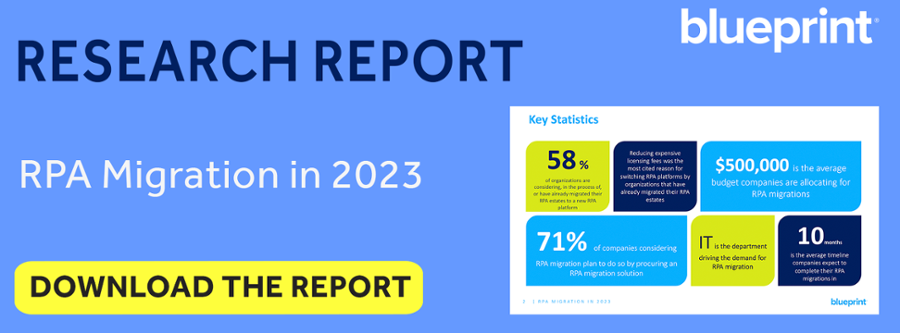The Top 4 Reasons Organizations Are Opting for RPA Migrations in 2023
Blueprint recently released the 2023 edition of its research on RPA migrations. One of the main objectives of the research was to understand why organizations are so aggressively interested in migrating their RPA estates to a new platform.
2023 has been an eventful year in the automation space. Some leading RPA providers have significantly raised their prices and licensing fees. Next-generation intelligent automation platforms like Microsoft Power Automate have caught up and offer much more simplified user experiences and cost-effective pricing, further motivating a flurry of activity in terms of RPA migrations.
According to the research Blueprint performed, these are the top four reasons so many organizations are investigating and actively migrating their RPA estates to new automation platforms.
Reduce Costs
For organizations that had already completed an RPA migration, reducing the cost of ownership and licensing fees for automation was the top cited reason that motivated their switch.
This was a new trend that emerged for this segment of the population when compared to Blueprint’s 2022 data on RPA migration. In 2022, the top reported reasons that motivated RPA vendor switches for those that had completed a change were:
- To leverage better capabilities and features
- Reduce the technical complexity of automation design and delivery
- Consolidate automation practices under one platform.
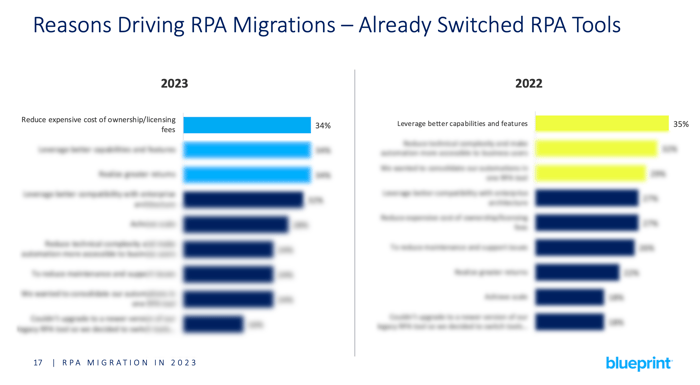
For the complete report and graph, download your very own copy of Blueprint’s RPA Migration in 2023 Research Report.
Clearly, reducing automation’s rising cost of ownership has become a top priority in 2023. That’s no surprise considering the instability of the global economy coupled with legacy RPA vendors raising their prices and licensing fees. With the possibility of a recession and price hikes from some of the industry’s leading RPA vendors, the desire to significantly reduce costs is the most prominent factor motivating RPA migrations.
Leverage Better Capabilities and Features
Organizations that reported to be currently considering RPA migration cited leveraging better capabilities and features as the greatest motivator behind their search for a new RPA platform.
Reducing the total cost of ownership and licensing fees was near the top of the list as well, however, the desire for a more robust RPA platform won out.
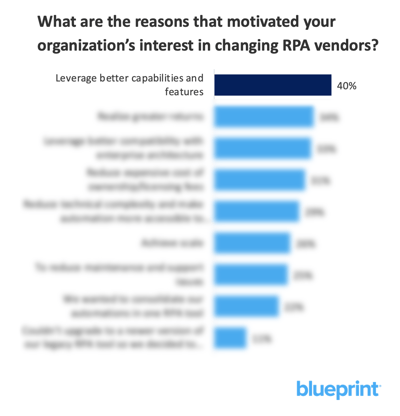
For the complete report and graph, download your very own copy of Blueprint’s RPA Migration in 2023 Research Report.
The desire for better capabilities and features is a natural occurrence that was very prominent in Blueprint’s 2022 research on RPA migration. Even with a high total cost of ownership, organizations have realized ample returns from their automation initiatives.
A desire to increase the ROI they’re realizing from their automation practice suggests they see intelligent automation platforms that offer more end-to-end automation of complex, decision-based business processes as the next step in their automation journey, spurring their search for a new RPA vendor.
Reduce Technical Complexity and Simplify Automation Design and Delivery
Organizations that are currently migrating their RPA estates to new platforms reported that reducing the technical complexity of automation delivery is the biggest factor motivating their RPA migrations.
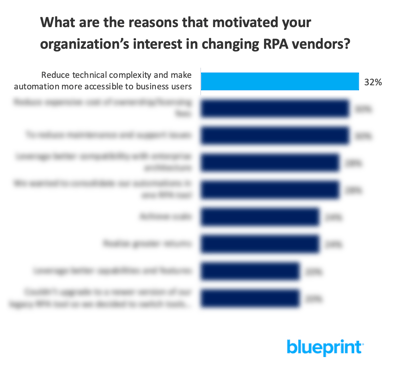
For the complete report and graph, download your very own copy of Blueprint’s RPA Migration in 2023 Research Report.
The goal is to make automation design and delivery more accessible to the average business user. Next-generation intelligent automation platforms like Microsoft Power Automate offer much more intuitive user experiences and simplified RPA delivery that promotes citizen development.
Citizen developers are then able to address and automate the long tail of RPA opportunities that mainly consist of simple business tasks clogging up the bottom of backlogs, left untouched as developers tackle the more complex, higher-priority business processes.
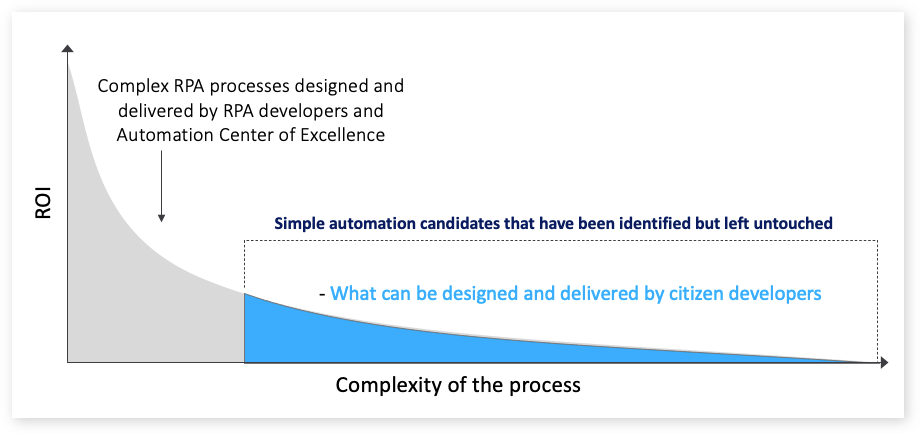
Leverage Better Compatibility with Enterprise Architecture
A common theme among all segments of Blueprint’s 2023 research on RPA migration was the desire to find an RPA platform that offers better compatibility with an organization’s enterprise architecture.
Logically, this is one of the reasons Microsoft Power Automate receives the lion's share of attention when organizations are migrating to a new RPA platform. Power Automate slides seamlessly into an organization’s tech stack with a significant Microsoft footprint.
Power Automate allows you to easily automate business processes that interact with any of Microsoft’s product suite, such as Azure, Office 365, and the rest of the Power Platform, while also offering a myriad of connectors to easily automate business processes that interact with non-Microsoft applications and services.
The reasons driving organizations to migrate their RPA estates to new automation platforms is just one component of Blueprint’s research on RPA migration in 2023. For all the insight the report has to offer like what the expected and realized benefits of RPA migration are, who’s driving and sponsoring the wish to switch providers, what challenges are being encountered, and how much organizations budgeting for RPA migration, download your very own copy today!
Share this
Recent Stories

The Top 7 RPA Trends of 2023

The 3 Ways Organizations Are Completing RPA Migrations in 2023


